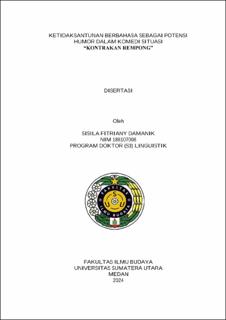| dc.description.abstract | This research examines language impoliteness in the sitcom "Kontrakan Rempong" which has humor potential. The objectives of this study are to (1) analyze semantic interpretation in humorous social interaction in the sitcom "Kontrakan Rempong", (2) analyze aggressive humor in the cast's language impoliteness in the sitcom "Kontrakan Rempong", (3) analyze the function of humor in the sitcom "Kontrakan Rempong", and (4) identify language varieties and social messages conveyed in the sitcom "Kontrakan Rempong".
This research seeks to contribute to the unexplored research field by formulating the methodology of impolite humor in the discourse of the sitcom "Kontarakan Rempong" systematically. In order to answer the problems and objectives of the research that have been formulated, the method used is qualitative method.
Based on the first problem statement, it was found that incongruity concepts makes an important contribution to our understanding of humor. The concept views humor understanding as a problem-solving task, and explains how humor can be understood after decoding the cognitive rules of incongruity, as well as how humor fails if incongruity resolution fails. Related to the concepts of incongruity, in this research of conversational humor in the sitcom "Kontrakan Rempong", taboo expressions are found that are the shared pleasure of both the cast and the audience. This is precisely what is more influential in a comedy. Similar to the concept of superiority, the situation comedy "Kontrakan Rempong" also found utterances in the form of words, phrases, sentences or screenshots of scenes that show impolite manner in a superior position. From this study, it can also be confirmed that the GTVH theory does function to analyze texts in the form of transcribed conversations from sitcoms with much longer storylines and also from screenshots of these sitcoms.
Based on the second problem statement, it was found that when humor is intended as playful aggression, speakers usually accompany their aggressive humor with explicit humor markers to encourage listeners to accept it in a non-serious and humorous way, so that listeners also interpret aggressively and comment in a humorous way. Thus, the key factor to determine whether aggressive humor conveys playful aggression or non-playful aggression is that the aggression is interactionally accepted or not as fun by the speaker and the listener in a conversation.
Meanwhile, based on the third problem formulation, it is found that the functions and strategies discussed in this study are not only considered from the speaker's point of view, in this case the cast in the sitcom "Kontrakan Rempong", but also consider the listener's response which is also very important in determining whether the communicative goals desired by the speaker have been achieved or not. These functions are solidarity, power and psychological functions. By applying the solidarity function of humor from Hay (2000), this study classifies the conversational data obtained from 20 episodes of the sitcom "Kontrakan Rempong" into 4 categories, namely, sharing (share), underlining similarities or experiences (highlight), clarifying and maintaining boundaries (boundS), and solidarity jokes (tease). The power function according to Hay (2000: 709-742) has the following categories; to foster conflict (to foster conflict), to control (to control), to determine limits related to power (to challenge and set boundaries), to tease in the form of criticism (to tease). And the third is psychological functions which consist of self-defense and self-protection functions. In this study, it was found that when the speaker (actor) uses humor to achieve certain social goals, the listener's interpretation and response are very important in determining whether the communicative goal the speaker wants has been achieved or not. In other words, listeners' responses can facilitate or reverse the speaker's intended purpose of interpersonal humor.
Based on the last problem formulation, it is found that the diversity of language or terms used by the cast in the sitcom "Kontrakan Rempong" is only negative impoliteness, nevertheless, all expressions or terms that are threatening, insulting, or demeaningly rude in the sitcom "Kontrakan Rempong" are merely entertaining, not giving full attention to the interlocutor's face or not paying attention to social expectations in communication. Acceptance of language diversity in the sitcom "Kontrakan Rempong" varies across different cultures and social groups. In humor, it is important to consider the context, cultural norms, and feelings of the people involved in the conversation. | en_US |


